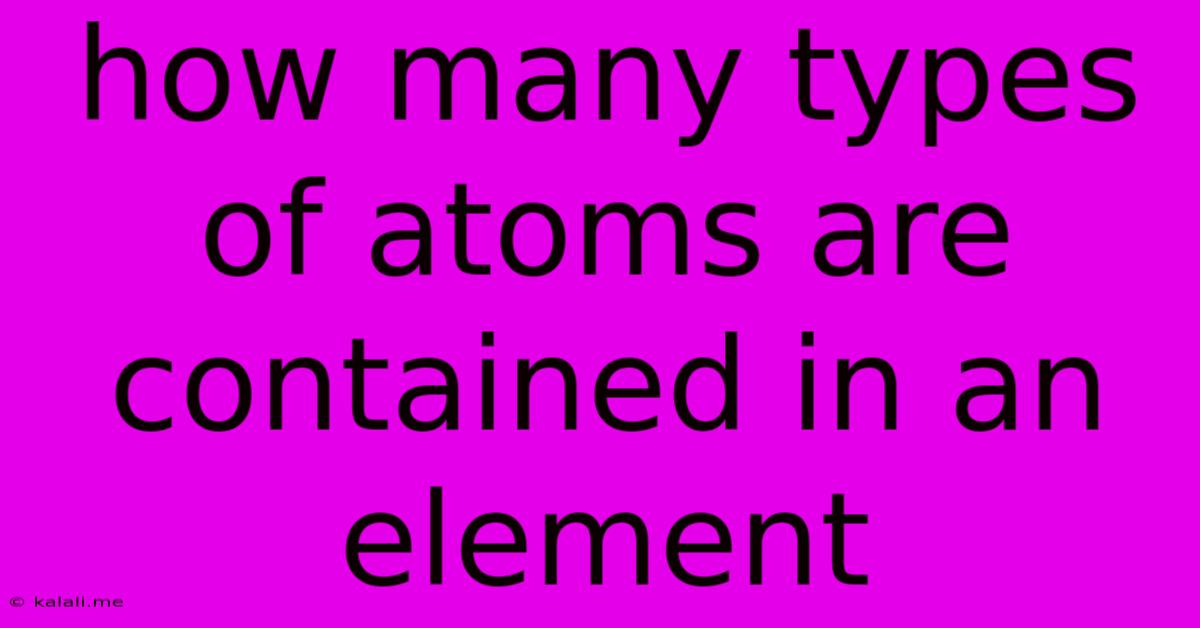How Many Types Of Atoms Are Contained In An Element
Kalali
May 20, 2025 · 2 min read

Table of Contents
How Many Types of Atoms are Contained in an Element?
Meta Description: Discover the fundamental relationship between atoms and elements. Learn why an element only contains one type of atom, despite isotopes and their varying neutron counts. This article clarifies the definition of an element and its atomic structure.
An element is a fundamental substance that cannot be broken down into simpler substances by chemical means. This seemingly simple definition holds the key to answering our question: how many types of atoms are contained in an element? The answer is one.
While this might seem counterintuitive given the existence of isotopes, let's delve deeper into the atomic structure and the definition of an elemental identity.
Understanding Atomic Structure
Every atom is composed of a nucleus containing protons and neutrons, orbited by electrons. The number of protons in an atom's nucleus defines its atomic number, which uniquely identifies an element. For instance, all atoms with one proton are hydrogen, those with two are helium, and so on. This proton number is the defining characteristic of an element.
The Role of Isotopes
Isotopes are atoms of the same element that have the same number of protons but differ in the number of neutrons. For example, carbon-12 and carbon-14 are both isotopes of carbon. They both have six protons (defining them as carbon), but carbon-12 has six neutrons, while carbon-14 has eight. This difference in neutron number affects the atom's mass, but not its chemical properties significantly. The chemical behavior of an element is primarily determined by the number of electrons, which is directly related to the number of protons.
Why Isotopes Don't Change the Element Type
Despite the existence of isotopes, an element only contains one type of atom. The term "type" refers to the number of protons, which determines the element's identity and its position on the periodic table. While isotopes exhibit variations in neutron count, these variations do not change the fundamental identity of the atom as a specific element. They are simply different versions of the same element, possessing slightly different physical properties (like mass) but maintaining the same chemical behavior.
Clarifying the Terminology
It's crucial to distinguish between the number of atoms and the number of types of atoms. An element can contain many atoms, but only one type of atom—defined by its atomic number or the number of protons in its nucleus. A sample of gold, for instance, contains countless gold atoms, but they all have 79 protons and therefore represent only one type of atom.
Conclusion
In summary, the number of types of atoms contained in an element is always one. The variations observed in isotopes, with their differing neutron numbers, do not alter the fundamental identity of the element determined by its atomic number (number of protons). Understanding this distinction is crucial for grasping the foundational principles of chemistry and atomic structure.
Latest Posts
Latest Posts
-
How To Stop A Cat Scratching At A Door
May 20, 2025
-
Depollution System Faulty Peugeot 207 Cc
May 20, 2025
-
Find Size Of File In Linux
May 20, 2025
-
Why Does My Hair Smell Burnt
May 20, 2025
-
How Do You Turn Off The Hot Water Supply
May 20, 2025
Related Post
Thank you for visiting our website which covers about How Many Types Of Atoms Are Contained In An Element . We hope the information provided has been useful to you. Feel free to contact us if you have any questions or need further assistance. See you next time and don't miss to bookmark.